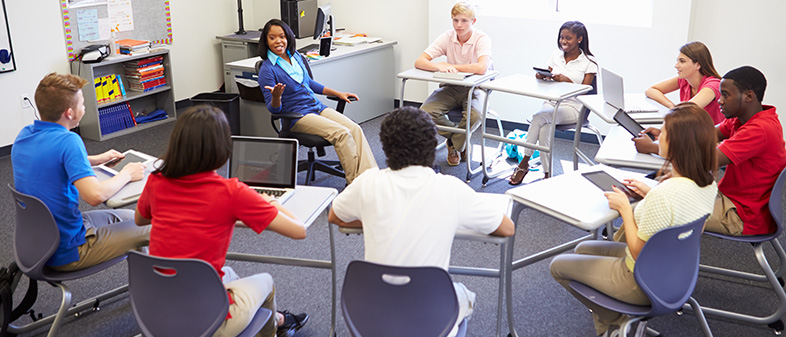
When educators decide to move from a more traditional learning environment to a 21st century learning environment, the first step is to gather information on how the proposed space will further the school's educational goals. New learning environments need to be more than just facelifts-they need to allow students to be more engaged in their activities than they had been in the more traditional spaces.
In this early phase of development, many questions about space requirements fall into the following three themes: student goals, teacher involvement and long-term sustainability. When educators understand these themes, they can better choose the physical attributes of the space that will make a difference to their students. Here are three questions to ask and answer as you begin planning to transition to a 21st century learning environment:
How will the new space better develop students' skills and abilities?
To ensure a new 21st century learning space is truly student-centered, we need to start by asking how the new space will impact students in a more positive way than their existing space does. This is more than just a question about what new activities students will be able to experience in the new space. It's a question that will ensure a deliberate fit between material offerings of the classroom and educational goals. By focusing on student proficiencies, educators can make decisions about items the new spaces will need. Answering this question allows educators to create a blueprint for continuing student development long after today's tools and technologies become yesterday's news. This focus on student growth helps educators to create metrics to assess whether the proposed space creates the desired benefits for their students.
Who will make this new space work?
New layouts, furnishings and equipment can set new expectations and spark opportunities for students, but skilled mentors and facilitators are vital for bringing activities to life in the new space. The most immediate and obvious facilitators in any classroom are teachers. It's important to make sure your educators have sufficient experience or training in the learning approaches that you want to promote in the proposed space. For example, if you want to create a collaborative learning space, you need to ensure your teachers have the skills needed to transition from lecture teaching to group facilitation. If teachers who do not currently have experience with the teaching techniques or the lesson plans you want to include in the proposed space, part of your planning process should include how you'll help your educators develop those skills.
Some spaces might also benefit from other facilitators like parents and members of the community. In many cases, parents can be a rich source of expertise for hands-on learning activities. For example, a parent might be a skilled gardener who can show children how to compost, grow vegetables or engage in various outdoor STEM activities. Parents with building skills might assist in makerspace projects, while those with computer experience might facilitate coding activities. Educators should also consider the extent to which they want to involve their community in the learning activities in the new space. In some cases, local businesses partner with schools to guide students in entrepreneurial activities using the new spaces. Community members can also introduce scenarios from their experiences, so students can apply their learning to realistic mock situations. Others might use their expertise to volunteer as mentors, guides or aides.
How do you plan to sustain the new space once it is implemented?
Plans for getting the new space off the ground must also include ideas for building momentum for continued student growth. Considerations could include plans for bringing new teachers and new activities into the proposed area. For example, a new makerspace might start with one or two zealous teachers with a passion for large-scale STEM activities. Over time, that space could become underutilized if other educators think it should only be used by those people for their kinds of projects. Lack of use could result in fewer opportunities for students and reduced support from educators, parents and other community members. To keep this from happening, part of the sustainability plan could include promoting cross-curricular activities and different kinds of projects.
Financial considerations also come into play when considering how to keep a new 21st century learning environment thriving in the long term. During the planning phase, educators can find creative avenues for replenishing consumables used in their new space. For example, the school might want to purchase new art supplies through money collected from outside groups or after-school clubs who might also be interested in using a new art space. Allowing outside groups to use new spaces also allows the community to invest in the school, potentially generating empathy for fundraisers, levies or other means of financial support. If outside groups are aware of the new projects, they may help spread the word about the school's efforts to develop students' potential.


